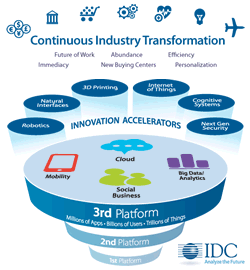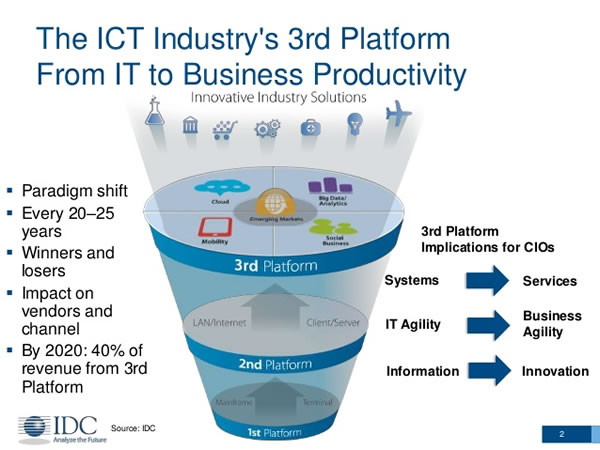Digital transformation is more than a ‘phenomenon’ and certainly more than a technological one. According to IDC we are even about to enter a genuine digital transformation economy, aka ‘DX economy’.
The obvious question: what would – or will – such an economy look like and what are its key drivers and characteristics? And how do we even get there? IDC predicted the advent of a so-called digital transformation economy at the occasion of its global IT industry predictions for 2016 and beyond.
According to the company digital transformation essentially builds upon the technologies it defined as being part of another term it coined, already 8 years ago: the third (3rd) Platform.
The adoption of the third platform: exponentially towards innovation and transformation
In 2007 IDC indeed introduced that ‘3rd Platform’ stating that its technological pillars (such as mobile devices, cloud computing services, big data – including analytics – and social networking or systems of engagement) and more specifically how they interdepend would be driving the future growth and innovation in the industry.

Whether you call it the third platform, Gartner’s ‘Nexus of Forces’ (the convergence of mobile, social, cloud and information) or the related SMAC (social, mobile, analytics and cloud), it’s clear that the mentioned technologies and their underlying shifting realities indeed have driven a lot in recent years.
That’s not a bad thing for IDC of course as, let’s face it, saying we were in the age of the third platform isn’t just a statement if you know that the first platform was essentially mainframe and the second platform the client-server model. In the third platform, cloud took and continues to take center stage while over the years new core 3rd Platform technologies were added (dubbed ‘innovation accelerators’, with some being more essential and even core as far as we’re concerned, such as the Internet of Things and cognitive systems – see image).
But, more important than the platforms, technologies, infrastructure models and delivery ‘tools’, was the adoption of it all.
This adoption has been exponential as we like to call it, both for business purposes and among consumers. And, yes, the faster adoption of many of these technologies for ‘personal reasons’ has left many organizations with challenges to catch up on top of all those challenges they already had.
The disruptive impact of digital transformation is about to be felt in every industry as enterprises flip the switch and massively scale up their DX initiatives to secure a leadership role in the DX economy (Frank Gens)
From innovation stage to DX economy: when digital transformation takes center stage at scale and with purpose
It’s this fast adoption of 3rd platform technologies that added a layer to the pillars of the third platform, IDC says: a layer of innovation and transformation which led us to an ‘innovation stage’.
Finally, it’s this phase of innovation and transformation that will accelerate in the next three to five years, ultimately leading to what the company calls the DX economy: an economy when digital transformation will be put at the center of growth and innovation strategies.

Given the context of IDC’s ‘prediction’ and the digital part in ‘digital transformation’ third platform technologies, including several additions to them, obviously play an essential role.
Customer intimacy and engagement: stakeholders lead the DX economy dance
But, of course we can’t overlook the importance of the desired outcomes of innovation and transformation capability such as optimization as mentioned in a previous blog post.
In that sense it’s probably not a surprise that IDC predicts that customer intimacy at scale will be the largest and most complex enterprise-wide (as in genuine digital transformation but also end-to-end customer experience and service excellence) digital transformation initiative facing organizations.
It requires an ability to ‘dramatically personalize customer service’, overhaul the digital front office and front doors (including the systems of engagement behind them) to ‘support 1,000 to 10,000 times more customers and customer touchpoints than today’. And a mix of deep cultural and operational transformation.
Customer-centricity and customer experience with customers being buyers and all possible stakeholders, including workers and partners where the new normal will be omni-experiences in the DX economy. Why wait?

